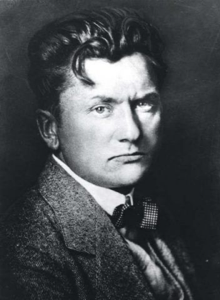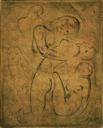Wilhelm Lehmbrück
German, (1881–1919)
Heinrich Wilhelm Lehmbrück first studied at the School of Applied Arts in Düsseldorf from 1895 to 1899. In 1901, he studied sculpture at the Royal Academy in Düsseldorf. Under the guidance of the sculptor Karl Janssen his craftsmanship was schooled, mainly in naturalistic and neo-classical genre sculpture. At the age of 23, Lehmbruck visited the International Art Exhibition in Düsseldorf which, presenting renowned artists from all over the world, brought current contemporary art to Düsseldorf for the first time. This is where he encountered the works of Auguste Rodin.
In 1907, Lehmbrück moved into his first studio in Düsseldorf and joined the Düsseldorf Artists’ Association. In the same year, four of his works were exhibited at the Paris Salon and Lehmbruck traveled to Paris for the first time. In June 1908, Lehmbruck married Anita Kaufmann. After successfully taking part in several exhibitions, the Lehmbrück family moves to Paris, where Wilhelm Lehmbruck visited Auguste Rodin in the latter’s studio in Meudon. Lehmbruck presented his works at the Salon of the Société nationale des beaux-arts, at the Berlin Secession, the Cologne Sonderbund Exhibition as well as the US Armory Show. During his time in Paris, he created some of his most important works such as the Standing Female Figure (1910), the Kneeling Woman (1911), the Large Pensive Woman (1913) and the Rising Youth (1913/14). When the First World War broke out, the family was forced to return to Germany. In December Lehmbruck moved into his new studio in Berlin. He served for a short time at an auxiliary military hospital in Berlin-Friedenau. At the end of 1916, Lehmbruck presented his works in a comprehensive solo show at the Kunsthalle Mannheim. After this exhibition, the family decided not to return to Berlin but moved south to Switzerland, in order to wait for the end of the war there. In Zürich, Lehmbrück met the young actor Elisabeth Bergner, who became his model. Lehmbrück developed strong feelings for her. At that time, his state of mind begins to deteriorate.
In 1919, shortly after the end of the war, Lehmbrück returned to Berlin for a commission. He studied Rudolf Steiner´s Anthroposophy and considers moving to India. In 1919 he signed an appeal by Steiner, which was meant to lay the foundations for a new social order after the catastrophe of the First World War. On 24 January 1919 Lehmbruck was appointed a member of the Prussian Academy of Arts, the highest recognition for a German artist. The announcement of this distinction, however, does not stop him from taking his own life on 25 March 1919 in Berlin. He was only 38 years old.
Source: lehmbruckmuseum.de
German, (1881–1919)
Heinrich Wilhelm Lehmbrück first studied at the School of Applied Arts in Düsseldorf from 1895 to 1899. In 1901, he studied sculpture at the Royal Academy in Düsseldorf. Under the guidance of the sculptor Karl Janssen his craftsmanship was schooled, mainly in naturalistic and neo-classical genre sculpture. At the age of 23, Lehmbruck visited the International Art Exhibition in Düsseldorf which, presenting renowned artists from all over the world, brought current contemporary art to Düsseldorf for the first time. This is where he encountered the works of Auguste Rodin.
In 1907, Lehmbrück moved into his first studio in Düsseldorf and joined the Düsseldorf Artists’ Association. In the same year, four of his works were exhibited at the Paris Salon and Lehmbruck traveled to Paris for the first time. In June 1908, Lehmbruck married Anita Kaufmann. After successfully taking part in several exhibitions, the Lehmbrück family moves to Paris, where Wilhelm Lehmbruck visited Auguste Rodin in the latter’s studio in Meudon. Lehmbruck presented his works at the Salon of the Société nationale des beaux-arts, at the Berlin Secession, the Cologne Sonderbund Exhibition as well as the US Armory Show. During his time in Paris, he created some of his most important works such as the Standing Female Figure (1910), the Kneeling Woman (1911), the Large Pensive Woman (1913) and the Rising Youth (1913/14). When the First World War broke out, the family was forced to return to Germany. In December Lehmbruck moved into his new studio in Berlin. He served for a short time at an auxiliary military hospital in Berlin-Friedenau. At the end of 1916, Lehmbruck presented his works in a comprehensive solo show at the Kunsthalle Mannheim. After this exhibition, the family decided not to return to Berlin but moved south to Switzerland, in order to wait for the end of the war there. In Zürich, Lehmbrück met the young actor Elisabeth Bergner, who became his model. Lehmbrück developed strong feelings for her. At that time, his state of mind begins to deteriorate.
In 1919, shortly after the end of the war, Lehmbrück returned to Berlin for a commission. He studied Rudolf Steiner´s Anthroposophy and considers moving to India. In 1919 he signed an appeal by Steiner, which was meant to lay the foundations for a new social order after the catastrophe of the First World War. On 24 January 1919 Lehmbruck was appointed a member of the Prussian Academy of Arts, the highest recognition for a German artist. The announcement of this distinction, however, does not stop him from taking his own life on 25 March 1919 in Berlin. He was only 38 years old.
Source: lehmbruckmuseum.de
Artist Objects




